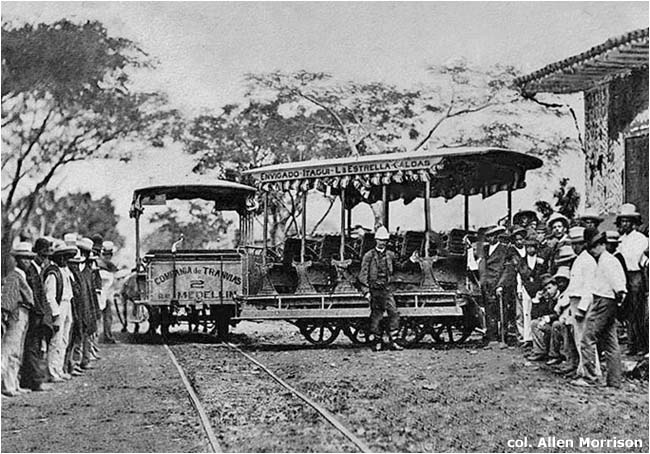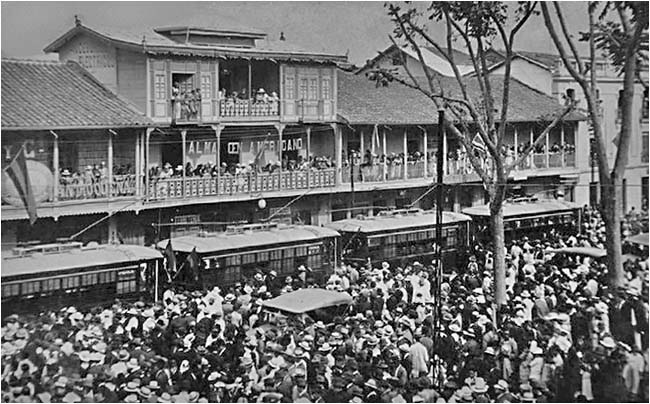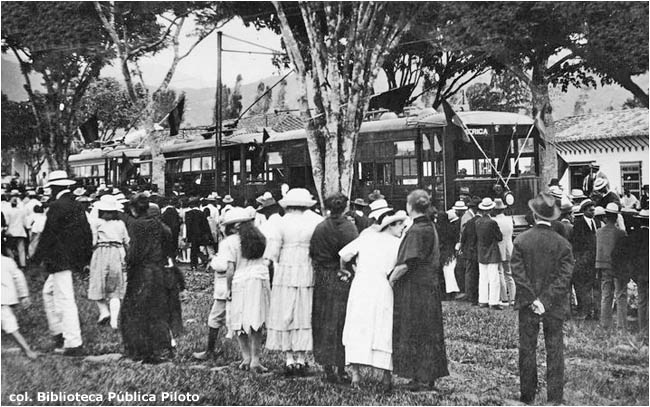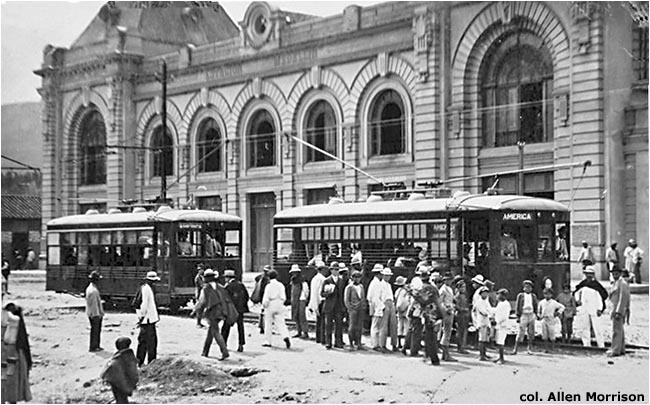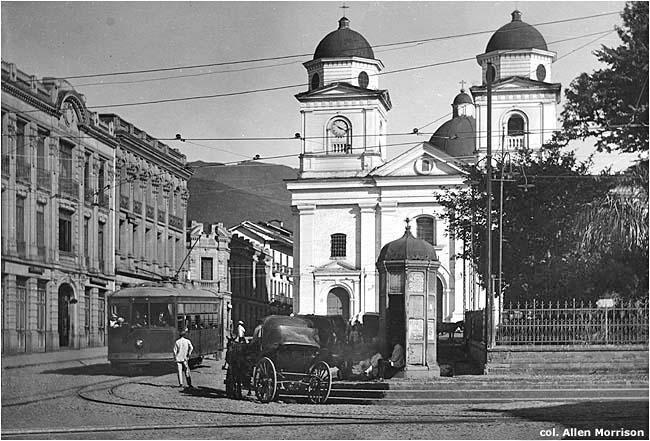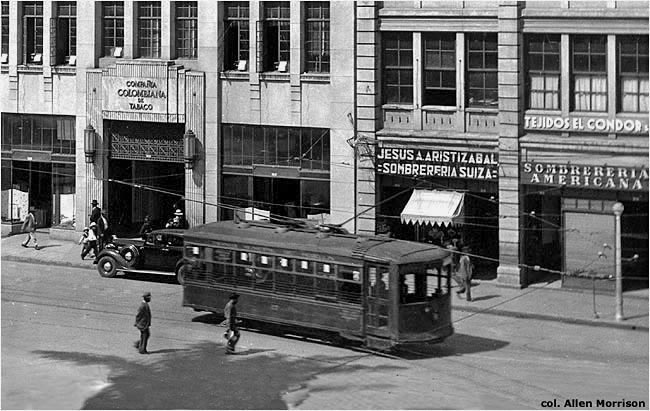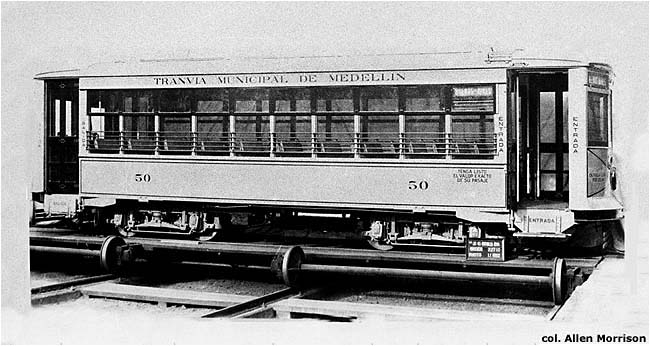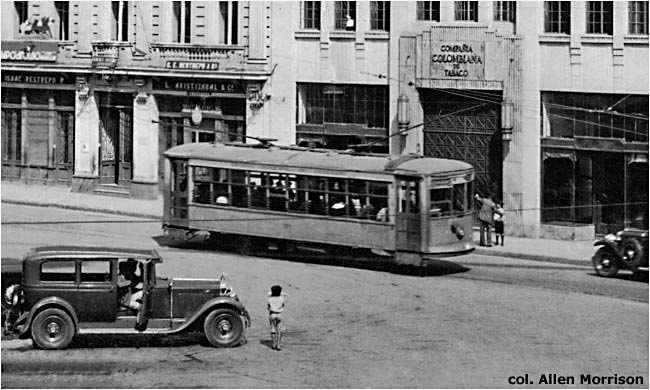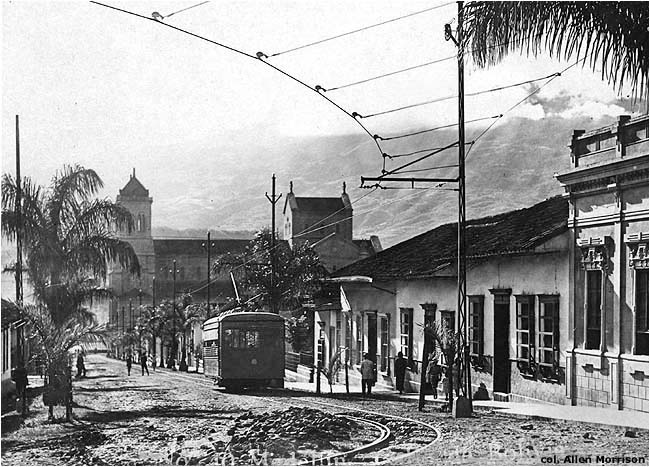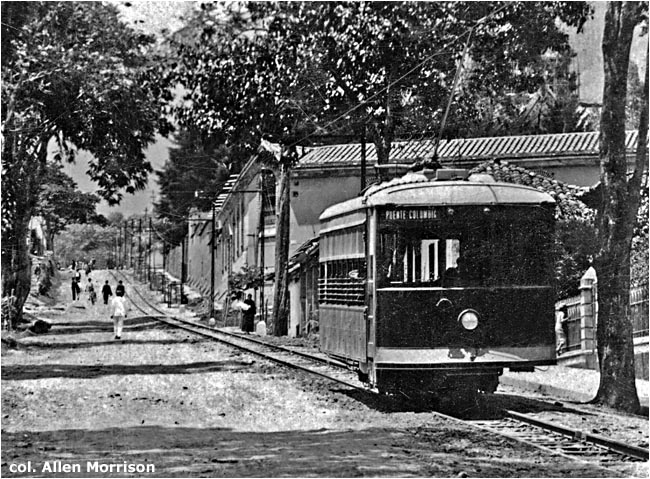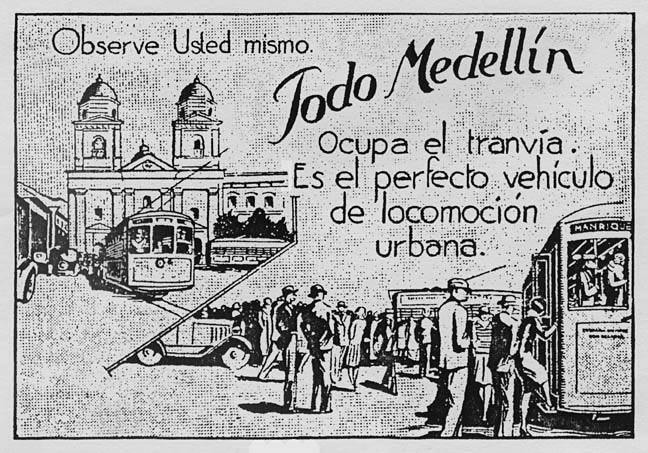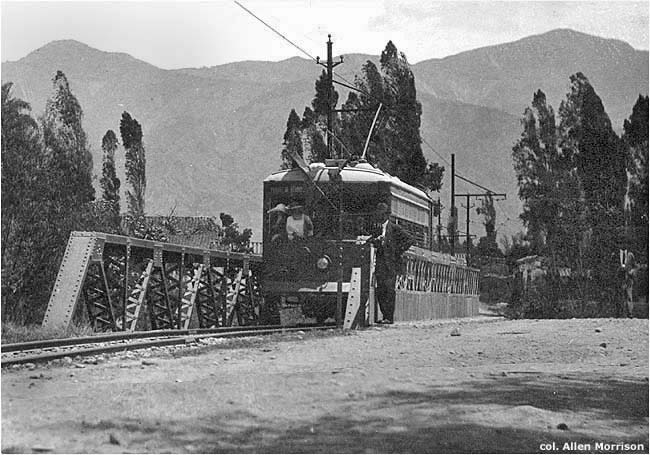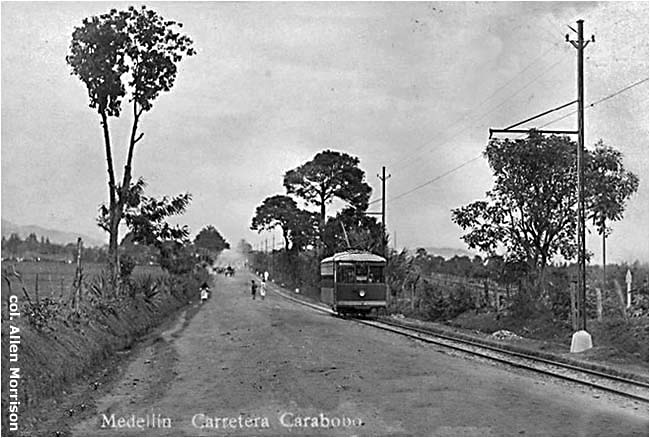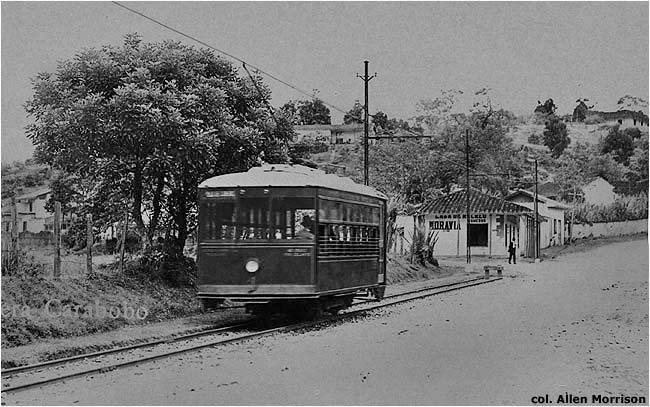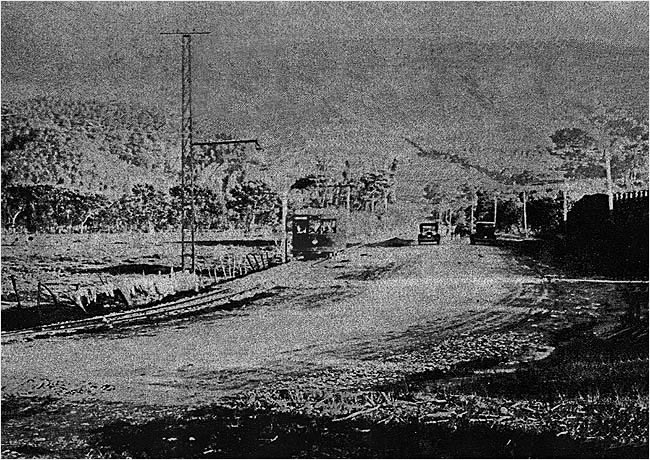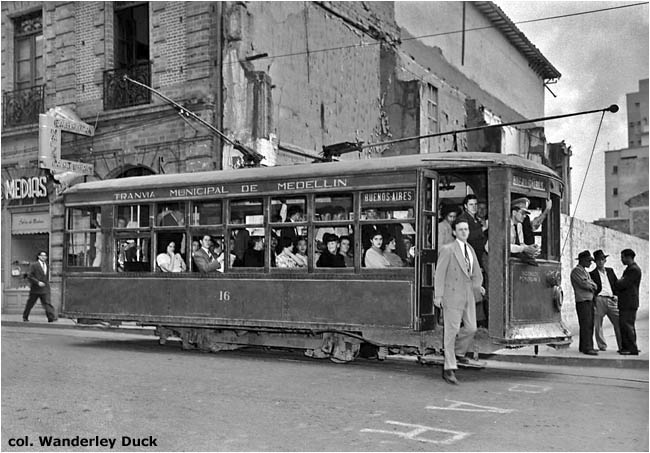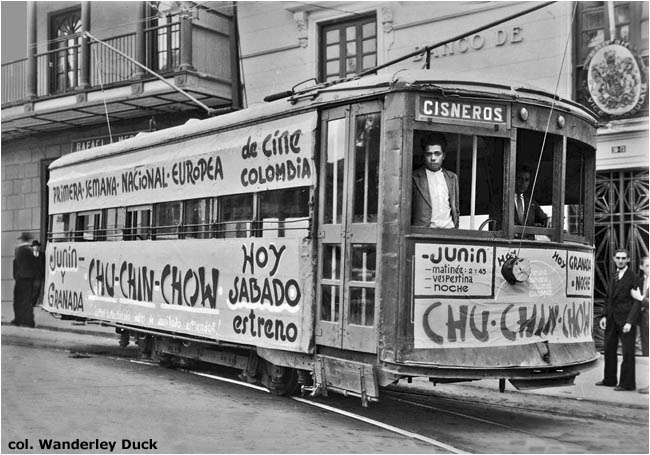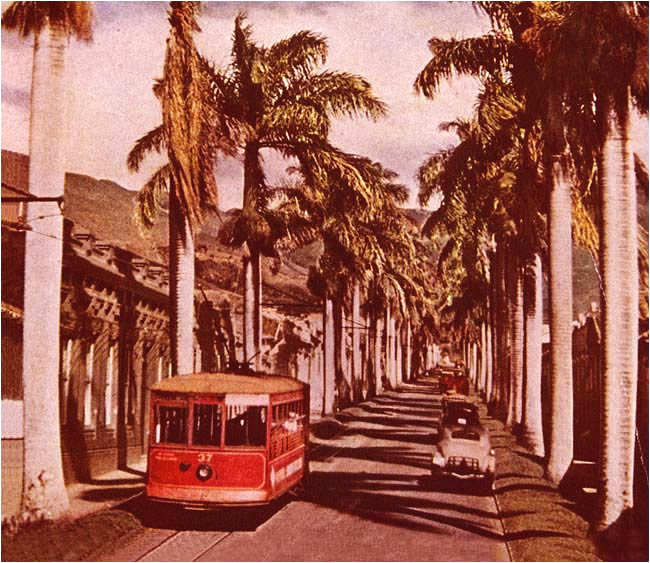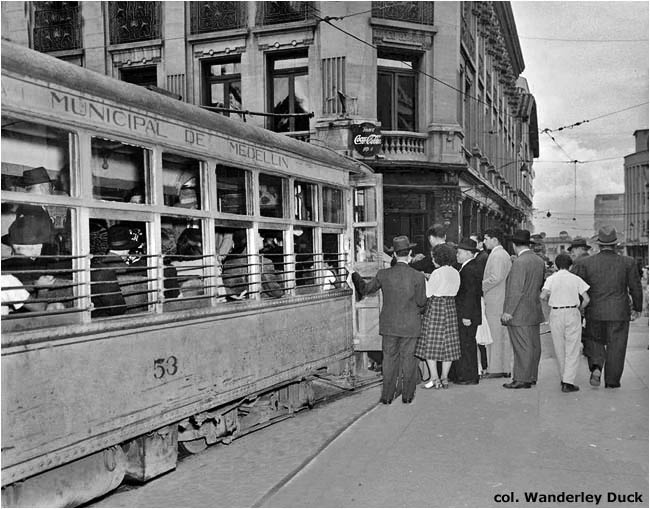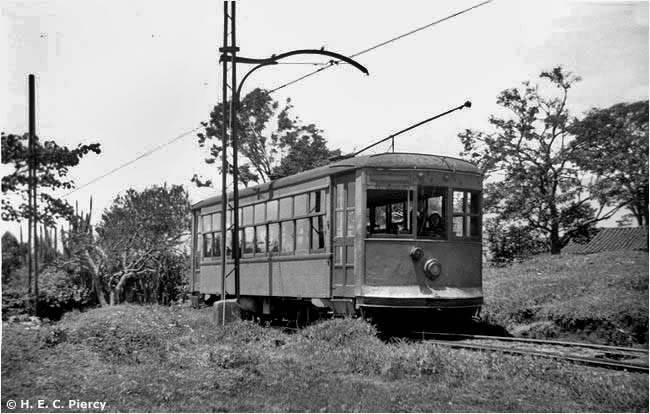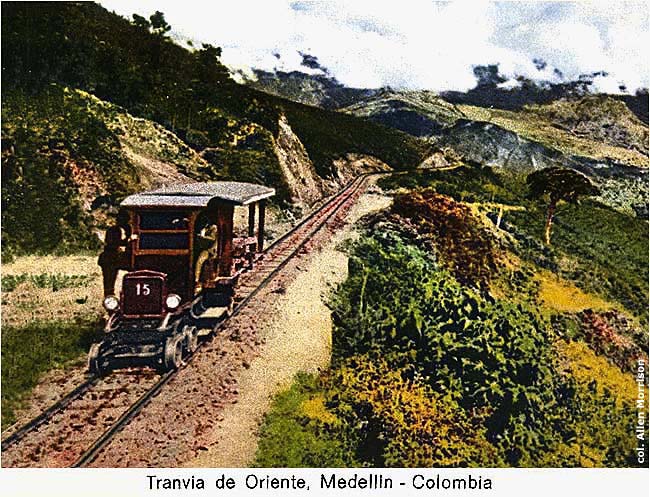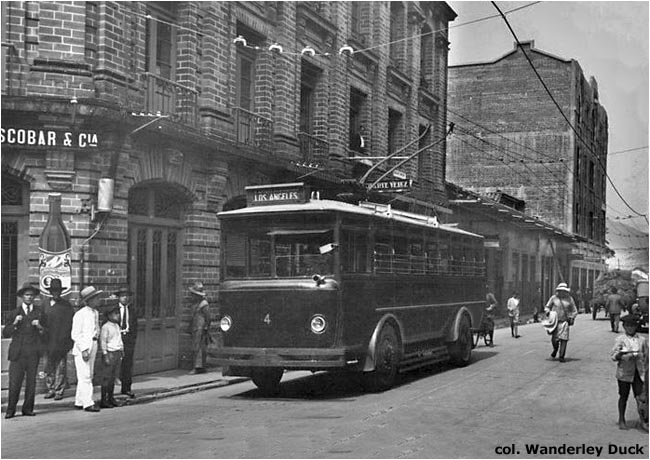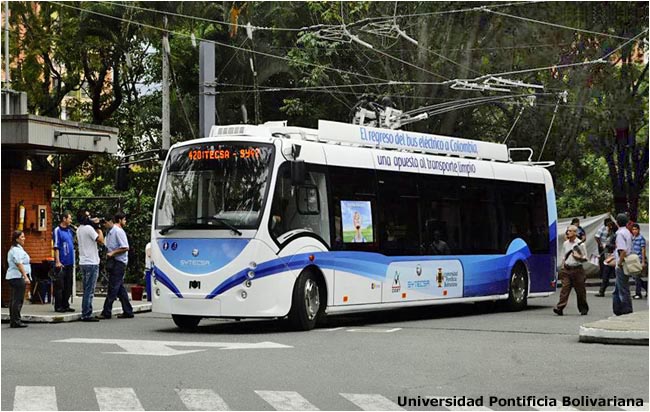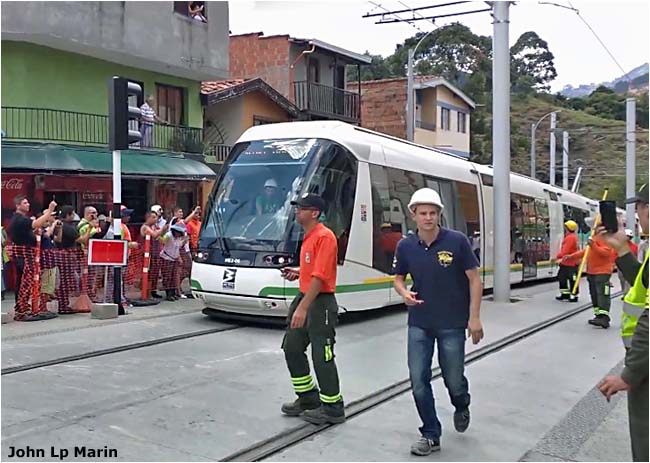Colombia's second-largest city, the capital of Antioquia department, lies in a valley carved by the Medellín River about 200 km northwest of Bogotá. Altitude is 1,500 m. The city's population in 1930 was about 100,000. The metropolitan area today has 3.7 million inhabitants. Medellín had a street railway a quarter century before it had a steam railroad. Ferrocarril de Medellín acquired an unknown number of horsecars from J. G. Brill in Philadelphia in 1886 – which seem to have been the same model that Bogotá acquired from Brill in 1884. Horsedrawn trams began carrying passengers along Carrera 52, between Plazuela de la Veracruz (near Parque Berrío) and El Edén, on 23 January 1887 [see map] [col. AM]:
The places named on the side of the car – towns far south of the city – were never reached by the horsecar line, which passed to a Belgian company in 1889 and closed in the 1890s. The city's first steam railroad, Ferrocarril de Amagá, finally opened a line from its station on Calle 44 to Caldas in 1911 [see map]. The second steam line, Ferrocarril de Antioquia, began operation in 1914. Both railroads used the same 914 mm / 36 in track gauge. Medellín introduced electric street lights in 1895, but did not consider electric traction until well into the 20th century. The Empresa de Tranvías Eléctricos, founded in 1919, was reorganized as Tranvía Municipal de Medellín in 1920 when its franchise was acquired by a government agency, Empresas Públicas Municipales. TMM/EPM ordered twelve 2-axle "Birney Safety Cars" from J. G. Brill Co. in Philadelphia on 24 June 1920, began construction, and inaugurated the city's first electric tram line, from Parque Berrío to América, on 12 October 1921 [see map]. The photograph below shows the inauguration [col. Biblioteca Pública Piloto de Medellín]:
The first electric trams arrive at América terminal [col. Biblioteca Pública Piloto de Medellín]:
The next picture, taken soon after, shows two "América" cars on Plaza de Cisneros in front of the the Ferrocarril de Antioquia station on Calle 44 [see map]. That handsome building is still there today – although it is no longer a railroad station [col. AM]:
This postcard view shows a Birney at the Parque Berrío terminus [see map]. Track gauge of the electric tramway was 914 mm / 36 in, the same used by the steam railroads [col. AM]:
TMM built 10 more tram routes and purchased 52 more Birney cars from Brill in the 1920s: 6 in 1923, 7 in 1924, 2 in 1925, 9 in 1926, 14 in 1927 and 14 in 1928. Six of the cars purchased in 1928 were large 4-axle models. The following view, taken in the 1930s, shows a 2-axle Birney on the other side of Parque Berrío [see map]. Note the Swiss and American hat shops [postcard, col. AM]:
Pictures of Medellín's 4-axle trams are rare, since they were not built until 1928 (after the postcard era) and there were only six. The following photograph was taken at the Brill factory before the double-truckers left Philadelphia [col. AM]:
The next postcard shows one of the six 4-axle models at the same location as the 2-axle model above [col. AM]:
The following postcard shows a tram climbing the grade on Calle 56, preparing to turn south on Carrera 43 [see map]. This is the Sucre tram line. Note the Andes beyond [col. AM]:
This car is climbing the steep grade on Calle 49 – today called Calle or Avenida Ayacucho – on the Buenos Aires line [see map]. This is the route of today's "Tranvía Ayacucho" (see below) [col. AM]:
The illustration below appeared in the 1930 Informe of the Empresas Públicas Municipales, operator of Tranvía Municipal de Medellín: "See for yourself. Everybody in Medellín rides the streetcar. It's the perfect way to get around town."
In addition to its electric tram lines, TMM also built a 5 km gasoline-powered line to El Poblado in 1925 [see map]. Three trams with internal combustion engines were purchased from Edwards Railway Motor Car Co. in Sanford, North Carolina, USA. But the service was short-lived and no pictures of TMM's gasoline cars have been found. The Poblado line was electrified in 1927 and extended to Envigado in 1929. Tranvía Municipal's suburban lines were picturesque. The Belén route [see map] crossed Río Medellín on its own steel trestle. This car is decorated with banners and flags – perhaps for the line's inauguration in 1926 [postcard, col. AM]:
The Aranjuez line opened as far as Bosque (a park) in 1921, was extended to Moravia in 1922, to Aranjuez in 1927, and finally reached Berlín in 1931 [see map]. This postcard view shows a tram on Carrera 52 ex-Carretera Carabobo [col. AM]:
Judging by the sign on the building, this is the Moravia terminus, where the tram in the previous photograph was headed [see map]. The picture must have been taken between 1922 and 1927, before the track was extended up the hill in the distance [postcard, col. AM]:
Image quality is poor, but this is the best illustration that the author could find of the 10 km Envigado line, which was one of the few genuine electric interurban tramway lines in South America [see map] [E. Livrado Ospina – see BIBLIOGRAPHY]:
The Buenos Aires tram line ran completely within the city [see map] [col. Wanderley Duck]:
The English motion picture "Chu-Chin-Chow" was made in 1934, so presumably this photograph was taken that year or soon after. Cisneros = Plaza de Cisneros, the tram terminus in front of the railroad station [see map]. Except for the motorman and friend, this tram has no passengers. It is touring the city just to advertise the film [col. Wanderley Duck]:
The October 1940 edition of National Geographic Magazine contained an article entitled "Hail Colombia!" which included the color photograph below. Birney 37 was climbing the hill on Calle 55, on the Sucre line [Luis Marden]:
An evening rush-hour crowd waits to board one of the 8-wheel double-truck cars about 1950 [col. Wanderley Duck]:
A transportation survey conducted by the U.S. Government in 1945 [see BIBLIOGRAPHY] found 61 trams running on 45 km of track in Medellín. But operation declined quickly after the War. A network of single-track lines with turn-outs was no longer adequate for a rapidly growing city, and gasoline buses replaced the trams one by one. When tramway enthusiasts visited Medellín in 1951 they found trams still in operation on only two lines: Aranjuez and Buenos Aires. These routes had survived no doubt because of the reserved track on the former and the steep grade on the latter. An Englishman took this photograph of an 8-wheel car on the twisting reserved track section of Aranjuez hill [see map] [H. E. C. Piercy]:
Both lines closed – Medellín's tramway system disappeared altogether on Sunday 7 October 1951. The city's electric tramway era had lasted just thirty years. Birney car 19 (renumbered 61) of 1924 has been preserved. See Medellín Cultura and Tranvía de Medellín. Medellín had another tramway company, Tranvía de Oriente, which also opened a gasoline-powered line in 1925. It ran eastward from Manrique [see map] over the mountains to Marinilla and Rionegro, total distance 52 km. Origin of the equipment is unknown, but it was probably also built by Edwards in the USA. Operation continued until 1942 [postcard, col. AM]:
If Medellín was late to install electric trams – nearby Panama City had them in 1893 – it was a pioneer in other forms of urban transportation. It was one of the first cities in Latin America to operate electric buses [see Trolleybus Pioneers]. Tranvía Municipal de Medellín purchased two trolleybuses from Ransomes, Sims & Jefferies in England in 1928 and opened a line to Los Angeles on 12 October 1929 [see map] – exactly eight years after it ran its first electric tram. It later bought more trolleybuses, built its own trolleybuses, and opened a second line to La Toma in 1934. The photograph below shows a Ransomes trolleybus on the Los Angeles line [col. AM]:
Metro de Medellín began the construction of a rapid transit railway in 1984, which it finally inaugurated in 1995. Route A runs from beyond Aranjuez in the north to beyond Itagüí in the south [see map]. Route B runs from the San Antonio metro station of Route A westward to San Javier, which is near the former terminal of the América tramway line. The system is continually expanding and is the only rapid transit railway in Colombia. There was an extraordinary development in 2011. Professor Andrés Emiro Díez Restrepo of Universidad Pontificia Bolivariana, an avid promoter of electric transport, wanted to bring trolleybus operation back to Medellín. In association with the Colombian-German firm SYTECSA, Prof. Díez built a 400 m trolleybus line around the UPB campus [see map] and imported a trolleybus to run on it from the Belkommunmash company in Belarus. The photo shows the inauguration of Medellín's "second trolleybus system" on 30 November 2011 [UPB]:
There was nothing else like this in the Americas. Prof. Díez wanted to acquire more vehicles and extend the line along Carrera 70 to the Estadio station of metro route B, just north of the campus [see map]. But the proposal was unsuccessful and his trolleybus ran only one year. However... On 13 May 2011 the city signed a contract with Lohr Industrie of France (acquired by Alstom in 2012) to build a "Translohr" line between San Antonio metro junction and the east side of town – a sort of eastward continuation of metro route B. A Translohr vehicle resembles a tram and draws power from overhead wires, but runs on rubber tires and is guided by a center rail. Such a vehicle should be ideal for climbing the 12% grade on Calle 49, also known as Avenida Ayacucho [see map] – which was the path of the Buenos Aires tram line until 1951. From two points on the line aerial cableways (teleféricos, Seilbahnen), each with two sections, will carry passengers even higher into the hills. Construction of the new "tramway" began in 2012, twelve Translohr vehicles arrived from France in 2014, and Metro de Medellín ran the first test on Monday 13 July 2015 [photo copied from a YouTube video by John Lp Marin]:
['jdapenao']: |
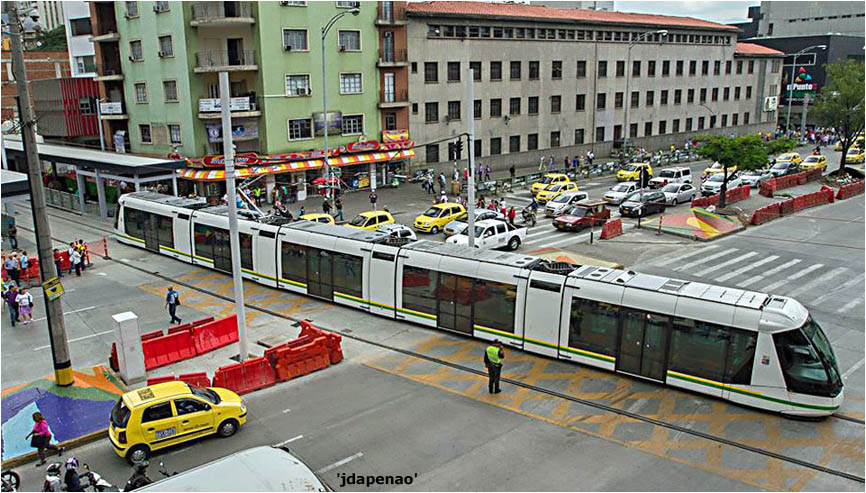
The next illustration comes from a video published on YouTube on 15 November [J.J. Escobar]: |
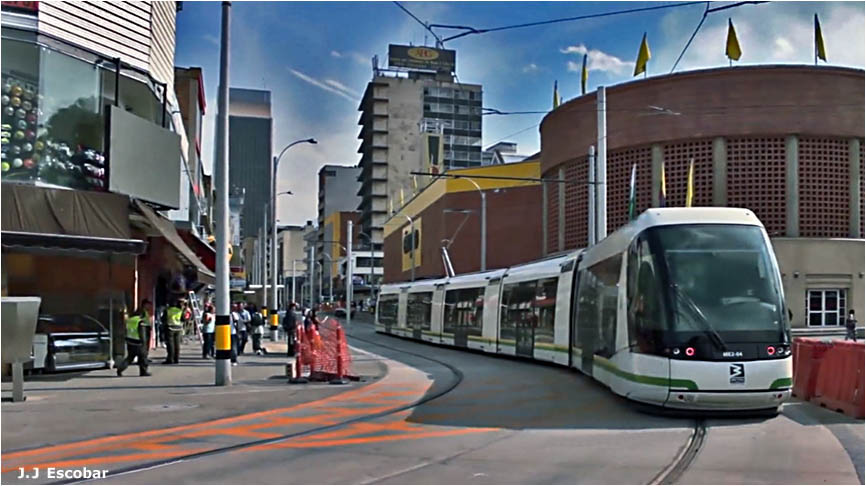
The Translohr line in Medellín is the first tramway of its kind in the western hemisphere.
[to be continued...]
BIBLIOGRAPHY Medellín. Empresas Públicas Municipales. Informe. The annual reports of the 1920s and 30s supply excellent data about the installation and operation of the city's trams and trolleybuses. Alfredo Ortega Díaz. Ferrocarriles Colombianos. Bogotá, 1920-1949. The chapter "Tranvía de Oriente de Medellín", p. 271, presents good technical and historical information. R. A. Bishop. The Electric Trolley Bus. London, 1931. Photograph and brief description of the Medellín trolleybus, p. 77. Medellín. Empresas Públicas Municipales. Plano General de Medellín, scale 1:10,000. Medellín, 1931. Superb large street map shows the tram routes, including the long Envigado line, in detail. Colombia. Departamento de Antioquia. Anuario Estadístico. Various editions in the 1930s and 40s present statistics about the Medellín tramway operation. United States. International Trade Office. Industrial Reference Service, vol. 4, part 1, no. 2 (February 1946). A 1945 transportation survey describes the operation and finances of the "Medellín Street Railway". E. Livardo Ospina. Una Vida, Una Lucha, Una Victoria: Monografía Histórica de las Empresas y Servicios Públicos de Medellín. Medellín, 1966. Tramway history, pp. 136-143, says that the system closed in 1946! (It closed in 1951.) The photograph of the Envigado line shown above was copied from an illustration opposite p. 190. Colombia. Departamento Nacional de Estadística. Medellín en Cifras: Ciudad tricentenaria, 1675-1975. Bogotá, 1976. "Movimiento del Tranvía Municipal desde su Inauguración", p. 246, records system size, rolling stock and passengers carried from 1921 to 1951. Confirmation that the system closed in the latter year. Uriel Ospina. Medellín Tiene Historia de Muchacha Bonita. Medellín, 1976. "Unos Armatostes Llamados Tranvías", pp. 111-114, is a colorful and affectionate tribute to the city's trams. Lisandro Ochoa. Cosas viejas de la villa de la Candelaria. Medellín, 1984. "Primer Tranvía de Medellín", pp. 166-169, describes the installation of the horsecar line – which, in contrast to other sources, this author says was inaugurated on 22 October (not 23 January) 1887. A. L. Minter. Medellín City Transport: A History. Sandwich (England), 1991. Impressive 67-page history, with emphasis on trams. Maps, charts and many illustrations. [See below.] "Los Años Felices del Tranvía" in El Colombiano (Medellín), 26/11/1995. Full-page newspaper article about Medellín's trams includes a striking, large overhead view of two Birneys. A. L. Minter. "Medellín City Transport: A History" in Tramway Review (London): part 1 in #172 (Winter, 1997); part 2 in #173 (Spring, 1998). Condensed, slightly revised version of the text above. New map. Juan Santiago Correa Restrepo. Los caminos de hierro: ferrocarriles y tranvías en Antioquia.
Bogotá, 2010. Chapter 4 - "Empresas de transporte urbano y
política pública: los tranvías en Antioquia
(1887-1951)", pp. 149-206, describes the development and decline of the
Medellín tramway, with emphasis on economic and political
aspects. Numerous illustrations. Fundación Museo del Transporte de Antioquia. Description and photographs of preserved Medellín tram 61. Robert Schwandl. The Urban Rail map of the Medellín metro shows aerial cableway extensions and the new Tranvía Ayacucho. José
Wilson Márquez Estrada. El Tranvía eléctrico de
Medellín (Colombia) y su aporte al proceso de
modernización urbana: 1920-1951. Medellín, 2012. Excellent history of the city's tramway development. Detailed maps. John Lp Marin. Tranvía de Ayacucho. YouTube video of the first test run, 13 July 2015. OpenStreetMap shows Ayacucho line with cableway extensions.
Also see and and
If you have comments, criticism or suggestions, This page was placed online on |
